Journal of Alcoholism & Drug Dependence
Open Access
ISSN: 2329-6488
ISSN: 2329-6488
Review Article - (2022)Volume 10, Issue 6
Alcohol addiction is worldwide problem this review information on adverse effects of Alcohol is alcoholism syndrome, and alcohol use disorder are all terms for the same thing. Every year, alcohol kills 3 million individuals worldwide, implying that a human being dies every 10 seconds. This accounts for 5.9% of all deaths. More than 200 diseases are linked to alcohol intake, and one out of every 20 people dies as a result of an alcohol-related sickness, injury, murder, accident, or suicide. Because they were alone, 85 percent of people drank alcohol. Excessive alcohol use can harm all organ systems, but it affects the brain, heart, liver, pancreas, and immune system the most.
Alcoholism; Health effects; Prevention; Treatment
Grapes, hops, rice, honey, and other components are used to make alcoholic beverages in the past [1]. Alcoholism is defined as excessive alcohol consumption that causes substantial mental or physical health consequences [2]. Drinking too much alcohol can harm all organ systems, but it is especially harmful to the brain, heart, liver, pancreas, and immune system [3]. Fetal alcohol spectrum disorders can be caused by drinking during pregnancy [4]. Due to their smaller body weight, poorer capacity to metabolize alcohol, and larger proportion of body fat, women are more vulnerable to the negative effects of alcohol than men [5]. Environmental and genetic variables play a role in the development of alcoholism, with each accounting for around half of the risk [6]. Social, cultural, and behavioral impacts are examples of environmental factors [7].
Sign and symptoms
Drinking a lot of alcohol over a long period of time, having trouble cutting back, procuring and drinking alcohol takes a lot of time, and consumption leading to withdrawal symptoms when you quit [8].
Long term abuse
The danger of alcoholism begins with little amounts of alcohol consumed and a habit of drinking large amounts of alcohol on a regular basis to the point of drunkenness, which is sometimes referred to as binge drinking (Figure 1) [9].
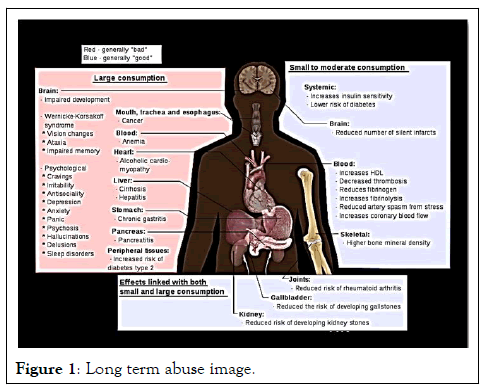
Figure 1: Long term abuse image.
Some of the long-term effects of ethanol may manifest itself in pregnant women, and alcohol can result in foetal alcohol pattern.
Short-term physical goods include
Drinking enough to achieve a Blood Alcohol Concentration (BAC) of 0.03–0.12 results in an overall improvement in mood and maybe swoon (a happy feeling), an increase in tone confidence and a decrease in nervousness, a flushed, red appearance in the face, and bloodied fine muscular judgments. Languor, drowsiness, balance issues, and blurred vision are all symptoms with a BAC of 0.09 to 0.25. A Blood Alcohol Content (BAC) of 0.18 to 0.30 results in significant disorientation, bloodied speech (e.g. slurred speed), stunning, dizziness, and vomiting [9,10].
Long-term goods include
Having more than one drink per day for women or two drinks per day for males raises the risk of heart disease, high blood pressure, and other health problems.
Each time, drinking is thought to be the cause of death [11]. Cirrhosis of the liver, pancreatitis, epilepsy, polyneuropathy, alcoholic lunacy, heart complaint, nutritive scarcities, and peptic ulcers are among of the physical indications of long-term misuse [12]. Sexual dysfunction, which can lead to foetal death. Other physical goods include the risk of acquiring cardiovascular disease, malabsorption, and alcoholic liver disease, as well as severe malignancies. Long-term alcohol intake can harm the central nervous system and the supplementary nervous system.
Alcoholic beverages
A boozehound drinks containing ethanol, also known as alcoholic beverages, are divided into three categories.
• Distilled spirit
• Beers
• Wines
Most countries allow them to be consumed legally, and over a hundred countries have laws governing their cultivation, sale, and consumption.
Beer
Beer is one of the oldest and most extensively consumed alcoholic drinks in the world and the third most popular drink overall after water and tea. The strength of ultramodern beer is generally around 4 to 6 alcohol by volume. Beer is an alcoholic libation produced by rooting raw accoutrements with water, boiling and turmoil (Figure 2).
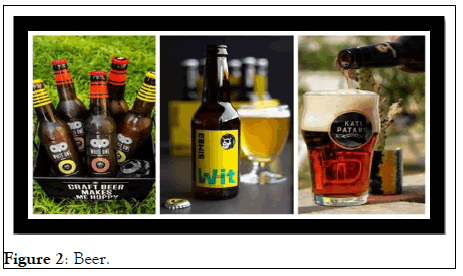
Figure 2: Beer.
Brands of beer
• Ale
• Barleywine
• Bittle ale
• Brown ale
• Pale ale
• Rundlet ale
• Mild ale
• Scotch aley
Wine
Is a fermented grape-based alcoholic beverage that consumes the sugar in the grapes and transforms it to ethanol and carbon dioxide while also producing heat? Alcohol by volume ranges from 6 to 21 (Figure 3).

Figure 3: Wine.
Variants
• Red wine
• White wine
• Rose wine
• Wine made from orange
• Wine made from fruits
• Sangria is a refreshing drink.
• Wine for the table
• sparkling wines
Distilled potables
A distilled libation, is an alcoholic drink containing ethanol that produced by distillation. It means of stirring Grains, fruits, botanicals, vegetables, seeds, and roots are just a few examples (Figure 4).
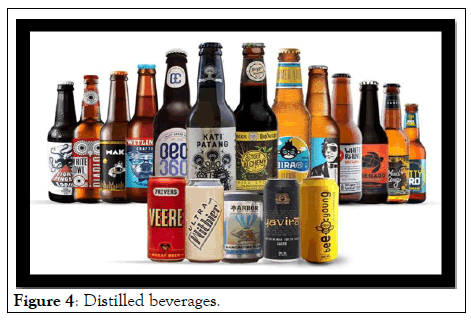
Figure 4: Distilled beverages.
Variants
Fruit distillation
• Apple distillation
• Applejack
• Fruit brandy distillation
• Palenka
• Calvados
• rakia
• medronho
• Borovicka
• Lambing
• Schnapps –L brandy
• Kirsch
• Eau-de-vie
Grapes/wine distillation
Brands
• Armagnac
• Cognac
• Metaxa
• Torkolypalinka
• Singani
Plum distillation
• Damassine
• Slivovitz
• Tuica
Jeer distillation
• Chambord
• Himbeergeist
Grain grounded distillation-Barley distillation
• Gin
• Man x spirit
• London dry gin
• Whiskey
• Irish whiskey
• Japanese whiskeys
• Scotch whiskey
Corn distillation
• American whiskey
• Bourbon whiskey
• Texas whiskey
• Tennessee whiskey
• Canadian whiskey
Oat distillation
• whiskey
• American whiskey
Rice distillation
• Awamori (Japan)
• Soju (Korea)
• Mirin (Japan)
• Schochu (Japan)
• Baiju (China)
Wheat distillation
• Horilka
• Vodka
Herbal distillation
• Absinthe
• Herbsainth
• Schnapps
• Geist
Factory base distillation
• Agave distillation
• Mazcal
• Tequila
Vegetable distillation
• Potato distillations
• Horilka
• Vodka
Alcohol side effects on human body
Brain: Alcohol interferes with the brain’s communication path way and can affect the way the brain looks and works these disruptions can change mood and behavior and make it harder to suppose fluently and move with collaboration. Difficulty blurred vision vocalized speech, slower response times, crippled memory. Fluently alcohol affects the brain some of this impairment are sensible after only one or two Drinks and snappily resolve when drink stops (Figure 5) [20].
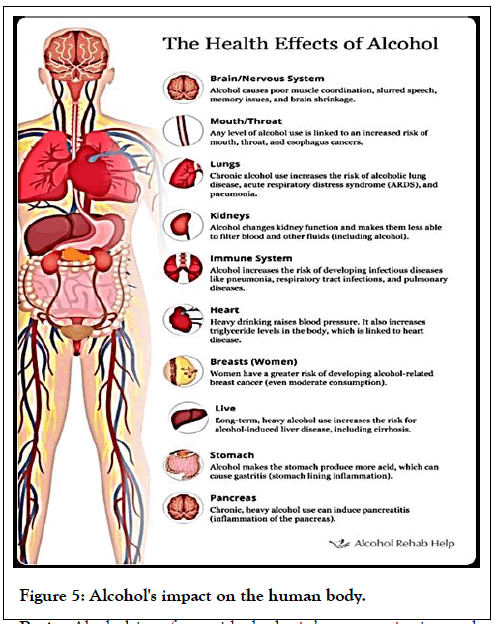
Figure 5: Alcohol's impact on the human body.
Drinking heavily over a long period of time can beget longlasting or endless changes to the brain.
The following are some of the signs and symptoms of brain damage:
• Poor memory
• Trouble learning new things
• Issues with teamwork and balance
• A shift in one's mood or personality
• Inattention and issues with attention
• Mental health issues such as anxiety and sadness
Alcohol and vulnerable system: Clinicians have long recognized a link between heavy alcohol intake and poor health outcomes, such as pneumonia vulnerability. In recent decades, this association has been extended to encompass a lower risk of ARDS, sepsis, Alcoholic Liver Disease (ALD), and various cancers; a higher rate of surgical complications; and a slower and less complete recovery from infection and physical damage, including poor crack mending.
Current reviews summarizes the evidence that alcohol changes susceptible circuits in a variety of seemingly paradoxical ways (ARCR). These alterations can have a negative impact on the body's ability to fight sickness, lead to alcohol related organ damage, and impair kerchief injury repair. We believe that a deeper knowledge of the particular mechanisms by which alcohol exerts its effects would be beneficial.
Breast (women’s): Women who drink roughly one drink per day had a 5 to 9% higher risk of developing bone cancer than women who do not drink at all, according to research. This problem worsens with each new drink they consume each day.
Pregnancy and alcohol: It is harmful to drink during pregnancy. Alcohol consumption during pregnancy can cause physical, cognitive, and behavioral issues in offspring, all of which can be variables in foetal alcohol spectrum disorders.
Some women abstain from consuming alcohol, such as:
• Anyone under the age of 21
• Anyone who takes medications that interact poorly with alcohol, such as sedatives, sleeping pills, pain relievers, or antianxiety medications
Liver: Alcohol in the blood starts to affect the heart and brain, which is how people become enraptured. Habitual alcohol abuse causes liver cell destruction, which leads to scarring of the liver (cirrhosis), alcoholic hepatitis, and cellular mutations that can lead to liver cancer (Figure 6).
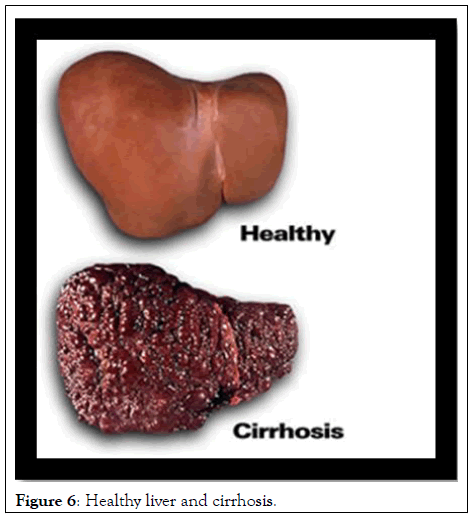
Figure 6: Healthy liver and cirrhosis.
When this happens symptoms can include:
• Symptoms of illness
• Weight loss
• Appetite loss
• Breadbasket with a lump in the ankles
• Befuddlement or drowsiness
• Passing blood in your coprolite or vomiting blood
• Liver adipose (steatosis)
• Liver inflammatory disease (hepatitis)
• Alcoholic hepatitis (acute)
• Fibrosis of the liver (cirrhosis)
• Hepatic failure, which can result in death
The liver breaks down the majority of the alcohol you consume so that it may be eliminated from your system. As a result, chemicals that are far more harmful than alcohol are created. These compounds have the potential to harm liver cells and cause serious liver problems. Alcohol is responsible for four out of every five deaths caused by liver disease.
Heart: Excessive alcohol consumption can cause high blood pressure, heart failure, and stroke. Cardiomyopathy, a condition that affects the heart muscle, can also be caused by excessive drinking. Furthermore, drinking can promote rotundity. Rapid heartbeat, high blood pressure, weakens heart muscle, and irregular twinkling all of this raises the risk of an alcohol-related heart attack or stroke (Figure 7).
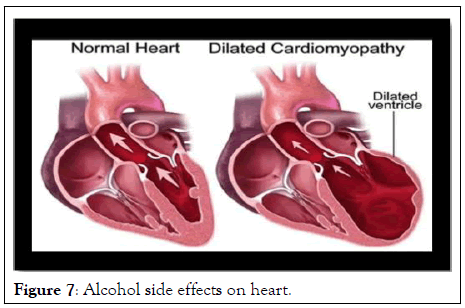
Figure 7: Alcohol side effects on heart.
The effects of alcohol on lung cells and the susceptible system are so well-known that it has been designated as an alcoholic lung pattern. According to one study, regular alcohol consumption can injure the lungs in as little as six weeks.
Inflammation and detriment cells can develop in both the upper and lower corridors of the airway as a result of alcohol misuse.
Lungs: When compared to non-alcoholics, rummies are at a higher risk of developing Acute Respiratory Distress Syndrome (ARDS) and have higher rates of ARDS death.
After substantial trauma to the lungs/respiratory system, alcohol abuse can lead to infection vulnerability. It increases the risk of aspiration of gastric acid, microorganisms from the upper region of the throat, mucous-assisted bacterial pathogen concurrence from the upper airway, and damaged pulmonary host defenses (Figure 8).
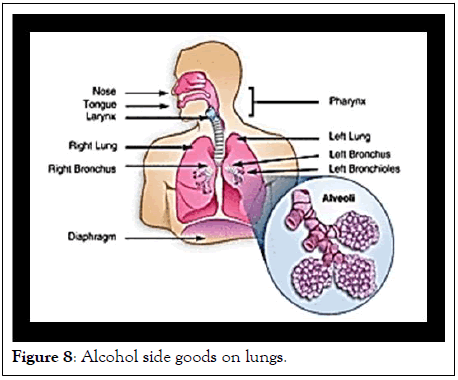
Figure 8: Alcohol side goods on lungs.
Stomach: Alcohol can cause an increase in the amount of acid in your stomach. This can aggravate your stomach's filling.
Causes include:
• gastroenteritis
• Ulcerative colitis
• influx
Stomach troubles might make you feel nauseous, bloated, or cause you to lose your appetite. However, if your stomach filling is inflamed, you may not be able to absorb nutrients from food.
Among the first signs are:
• breadbasket pain
• heartburn
• losing your appetite
• nausea( feeling sick)
• vomiting( getting sick)
Gastritis can occur without causing any symptoms. However, if left unchecked, gastritis can evolve to stomach ulcers, which might result in death. Stomach ulcers are painful open blisters that form in the stomach lining. Ulcers might make you nauseous or make you heave.
Increase in weight: Cutting back on alcohol is a simple approach to lose weight without changing your diet. Drinking more than the low-risk levels on a regular basis can alter your weight over time.
Obesity and rotundity are connected to illnesses such as
• Diabetes
• Heart disease
• Stroke
• Depression
• Cancer
Why does alcohol make you gain weight?
Alcohol contains the same number of calories per gram as pure fat. Alcohol calories, on the other hand, are empty calories. Alcohol isn't as nutritive as food, so the calories in it aren't as high.
Kidney: As sludge for harmful compounds, the feathers have a crucial role. Alcohol is one of these drugs. Heavy alkies' feathers have to work harder. Alcohol alters the function of the feathers, making them less effective in filtering blood. Alcohol also impairs the body's capacity to manage fluid and electrolytes. The drying action of alcohol can disrupt the proper operation of cells and organs, including the feathers, when it dehydrates (dries out) the body. Furthermore, drinking can disrupt hormones that impact how well the body functions (Figure 9).
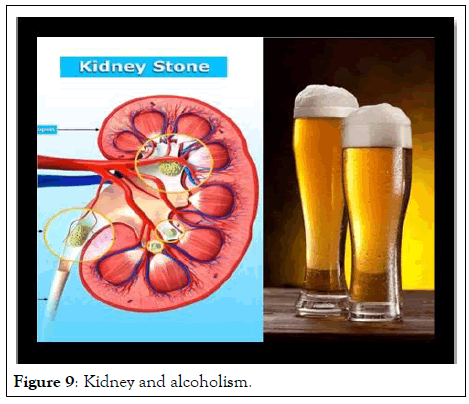
Figure 9: Kidney and alcoholism.
An excessive amount of alcohol can also have a negative impact on your blood pressure. People who consume excessive amounts of alcohol are more likely to have high blood pressure. Alcohol can also impact the characteristics of high blood pressure.
Fertility and sex life
When you drink alcohol, you can expect to see an increase in:
• Self-assurance when it comes to sexual partners
• Sexual arousal
• Long-term issues with coitus and fertility can also be caused by alcohol.
What effect does alcohol have on coitus and fertility?
Construction issues include:
• Drinking a lot of alcohol can make it difficult to secure or keep a construction job. This is referred to as Erectile Dysfunction (ED).
• Alcohol disrupts the brain's messengers, which tell the penis to fill with blood.
• It could also be due to the fact that alcohol lowers testosterone production. Testosterone is a hormone that regulates male sexual behavior.
• ED is usually only a short-term issue.
Problems with organisms include the following:
Alcohol impairs your ability to experience sexual stimulation. It accomplishes this by eavesdropping on signals sent between the brain and the genitals.
Alcohol can impact your appearance in additional ways than the beer belly and toper's nose.
Dry skin wrinkles:
• Alcohol dehydrates your body
• Dry skin wrinkles more quickly and appears dull and slate.
• The diuretic (water-loss) effect of alcohol promotes vitamin and nutritional loss. Vitamin A, for example. This is critical for skin health.
Skin issues include:
The skin condition rosacea can be aggravated by alcohol.
The following are some of the signs and symptoms of rosacea:
• a greenish tint
• blood vessels that have inflated
• red lumps on the skin
Broken blood vessels and a greenish tint to your skin are also possible side effects. 90 percent of rosacea patients who cut back on alcohol think it helps them have fewer flare-ups.
Inflammation: Water retention in the face can be caused by drinking alcohol. Your face will appear swollen and puffy as a result of this.
Eyes that is bloodshot: Alcohol might irritate the blood vessels in your eyes' face, causing them to swell.
Treatment
Disulfiram: Disulfiram acts by blocking the enzyme acetaldehyde dehydrogenase, causing many of the effects of alcohol use to be felt incontinently.
Disulfiram combined with alcohol causes flushing, a palpitating headache, respiratory difficulty, nausea, riotous vomiting, sweating, thirst, casket pain, pulsation, dyspnea, hyperventilation, fast heart rate, low blood pressure, fainting, pronounced uneasiness, weakness, vertigo, blurred vision, and confusion. Respiratory depression, cardiovascular collapse, abnormal cardiac measurements, heart attack, acute congestive heart failure, unconsciousness, storms, and death are all possible outcomes of severe reactions.
Alcohol is broken down in the liver by the enzyme alcohol dehydrogenase to acetaldehyde, which is then transformed to an innocuous acetic acid byproduct by the enzyme acetaldehyde dehydrogenase (acetyl coenzyme A), Disulfiram.
Benzodiazepines: Benzodiazepines are useful for both symptom management and seizure prevention. Vitamins play a crucial role in the alcohol withdrawal pattern's operation. Benzodiazepines are the most commonly prescribed medicine for the treatment of alcohol withdrawal, and they are generally safe and effective in reducing withdrawal symptoms. Although benzodiazepines have a long history of successfully treating and preventing pullout, there is no consensus on which one is the best. Longacting benzodiazepines, such as chlordiazepoxide and diazepam, are the most commonly utilized drugs. When compared to other conventional treatment options, benzodiazepines exhibited a protective advantage against alcohol withdrawal symptoms, particularly seizure.
Vitamins: Individuals with an alcohol use disorder are often low in colored nutrients, which can lead to serious difficulties during alcohol withdrawal, such as the formation of Wernicke pattern. These individuals should be given a multivitamin with adequate doses of thiamine and folic acid to help them with Wernicke pattern. Before initiating any carbohydrate-containing fluids or food during alcohol withdrawal, intravenous thiamine, folic acid, and pyridoxine should be given as a precaution. For intravenous delivery, these vitamins are typically mixed into a banana bag.
To avoid further drinking, take the following steps:
The drugs naltrexone, acamprosate, and disulfiram are used to aid with the return to drinking. They're used once the pullout period has ended.
[Crossref] [Googlescholar][Indexed]
[Indexed]
Citation: Misal GD, Gawade SP (2022) The Effects of Alcohol on Humans and the Alcohol Dependency Syndrome. J Alcohol Drug Depend. 10:367.
Received: 01-Jun-2022, Manuscript No. JALDD-22-17697; Editor assigned: 03-Jun-2022, Pre QC No. JALDD-22-17697(PQ); Reviewed: 17-Jun-2022, QC No. JALDD-22-17697; Revised: 02-Aug-2022, Manuscript No. JALDD-22-17697(R); Published: 09-Aug-2022 , DOI: 10.35248/2329-6488.22.10.372
Copyright: © 2022 Misal GD, et al. This is an open-access article distributed under the terms of the Creative Commons Attribution License, which permits unrestricted use, distribution, and reproduction in any medium, provided the original author and source are credited.